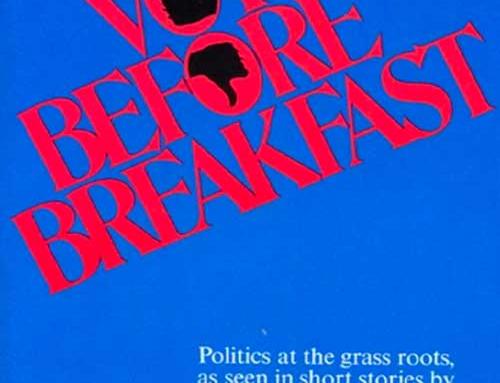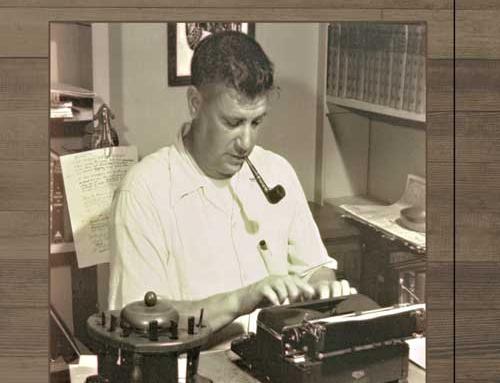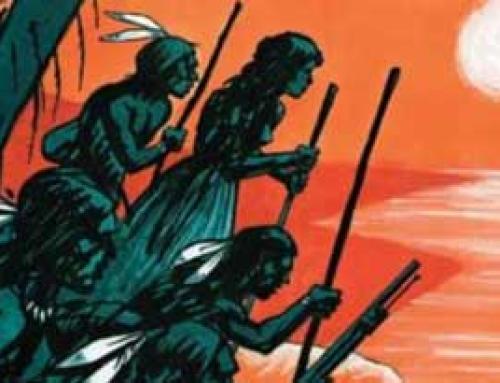Jesse Stuart was born on August 8, 1906. To celebrate his birthday and his many contributions to life in eastern Kentucky, my next three articles will focus on Stuart’s life and works.
The late Poet Laureate of Kentucky, Jesse Hilton Stuart, published 2,000 poems, 460 short stories, and more than 60 books. He was one of Appalachia’s best known and most anthologized authors, and his works have been translated into many foreign languages. In 1976, eight years before his death, the editors of Country Gentleman magazine boldly proclaimed that Jesse Stuart was “America’s most famous chronicler of rural life.”
 Yet his contributions are more than literary. During his life, this important educator and charismatic author served as a leader for the people of his mountain homeland and as a spokesman for their values. His life and works still attract hundreds of tourists to eastern Kentucky every year. Jesse’s father taught him to love and respect the land, and Jesse became a far-sighted conservationist – donating over 700 acres of his land in W-Hollow to the Kentucky Nature Preserve System in 1980.
Yet his contributions are more than literary. During his life, this important educator and charismatic author served as a leader for the people of his mountain homeland and as a spokesman for their values. His life and works still attract hundreds of tourists to eastern Kentucky every year. Jesse’s father taught him to love and respect the land, and Jesse became a far-sighted conservationist – donating over 700 acres of his land in W-Hollow to the Kentucky Nature Preserve System in 1980.
Jesse Stuart was born in northeastern Kentucky’s Greenup County, where his parents, Mitchell and Martha (Hilton) Stuart, were impoverished tenant farmers. Mitchell Stuart could neither read nor write, and Martha had only a second-grade education, but they taught their two sons and three daughters to value education. Jesse graduated from Greenup County High School in 1926 and from Lincoln Memorial University in Harrogate, Tennessee, in 1929. He then returned to Greenup County to teach.
By the end of the 1930s, Stuart had served as a teacher in Greenup County’s one-room schools and as high school principal and county school superintendent. These experiences served as the basis for his autobiographical book, “The Thread That Runs So True” (1949), hailed by Dr. J. Elmer Morgan, founder and president of the National Education Association, as “the best book on education written in the last 50 years.” The book became a road map for educational reform in Kentucky. By the time it appeared, Stuart had left the classroom to devote his time to lecturing and writing. He returned to public education as a high school principal in 1956-57, a story told in “Mr. Gallion’s School” (1967). He later taught at the University of Nevada in Reno in the 1958 summer term, served on the faculty of the American University in Cairo in 1960-61, and taught in writing workshops at Murray State College in the 1970s.
Stuart began writing stories and poems about Appalachia in high school and college. During a year of graduate study at Vanderbilt University in 1931-32, Donald Davidson, one of his professors, encouraged him to continue writing about his land and his people. “Man With a Bull-Tongue Plow,” a collection of 703 poems, appeared in 1934 and was widely praised by reviewers and general readers. One critic likened Stuart to Robert Burns as a poet “who captured the heart and soul of his people.”
Stuart began his autobiographical “Beyond Dark Hills” while he was at Vanderbilt. Published in 1938, it inspired readers to follow Stuart’s example of overcoming obstacles to obtain an education. “Head o’ W-Hollow” (1936) and “Men of the Mountains” (1941) were followed by more than a dozen Stuart short story collections which appeared in his lifetime.
He was a widely-read novelist, and critics such as J. Donald Adams ranked Stuart as a first-class local colorist.
Stuart was also a successful poet. His ten volumes of verse include “Album of Destiny” (1944) and “Kentucky Is My Land” (1952). He was designated as the Poet Laureate of Kentucky in 1954 and was made a fellow of the Academy of American Poets in 1961.
Throughout his adult life, Stuart received numerous honors as a writer and educator. October 15, 1955, was proclaimed “Jesse Stuart Day” by the governor of Kentucky and a bust of Stuart, which is still standing, was unveiled on the Greenup County Courthouse lawn. In 1958, he was featured on “This Is Your Life,” a popular television show. In 1972, the lodge at Greenbo Lake State Resort Park was named the Jesse Stuart Lodge.
Stuart was disabled by a stroke in 1978, and a few years later, in May 1982, he suffered another stroke, which rendered him comatose until he died on February 17, 1984. He is buried in Plum Grove Cemetery in Greenup County, close to W-Hollow, the little Appalachian valley that became a part of the American imagination through his world-famous books.
To read more about this famous author and educator, I recommend “Jesse Stuart: An Extraordinary Life,” an easy-to-read, 478-page hardback book that contains hundreds of valuable photographic illustrations. This book is available at the Jesse Stuart Foundation Bookstore at 4440 13th Street in Ashland. For more information call 606-326-1667 or email jsf@jsfbooks.com.
By James M. Gifford
JSF CEO & Senior Editor
Jesse Stuart was born on August 8, 1906. To celebrate his birthday and his many contributions to life in eastern Kentucky, my next three articles will focus on Stuart’s life and works.
The late Poet Laureate of Kentucky, Jesse Hilton Stuart, published 2,000 poems, 460 short stories, and more than 60 books. He was one of Appalachia’s best known and most anthologized authors, and his works have been translated into many foreign languages. In 1976, eight years before his death, the editors of Country Gentleman magazine boldly proclaimed that Jesse Stuart was “America’s most famous chronicler of rural life.”
Yet his contributions are more than literary. During his life, this important educator and charismatic author served as a leader for the people of his mountain homeland and as a spokesman for their values. His life and works still attract hundreds of tourists to eastern Kentucky every year. Jesse’s father taught him to love and respect the land, and Jesse became a far-sighted conservationist – donating over 700 acres of his land in W-Hollow to the Kentucky Nature Preserve System in 1980.

Jesse Stuart was born in northeastern Kentucky’s Greenup County, where his parents, Mitchell and Martha (Hilton) Stuart, were impoverished tenant farmers. Mitchell Stuart could neither read nor write, and Martha had only a second-grade education, but they taught their two sons and three daughters to value education. Jesse graduated from Greenup County High School in 1926 and from Lincoln Memorial University in Harrogate, Tennessee, in 1929. He then returned to Greenup County to teach.
By the end of the 1930s, Stuart had served as a teacher in Greenup County’s one-room schools and as high school principal and county school superintendent. These experiences served as the basis for his autobiographical book, “The Thread That Runs So True” (1949), hailed by Dr. J. Elmer Morgan, founder and president of the National Education Association, as “the best book on education written in the last 50 years.” The book became a road map for educational reform in Kentucky. By the time it appeared, Stuart had left the classroom to devote his time to lecturing and writing. He returned to public education as a high school principal in 1956-57, a story told in “Mr. Gallion’s School” (1967). He later taught at the University of Nevada in Reno in the 1958 summer term, served on the faculty of the American University in Cairo in 1960-61, and taught in writing workshops at Murray State College in the 1970s.
Stuart began writing stories and poems about Appalachia in high school and college. During a year of graduate study at Vanderbilt University in 1931-32, Donald Davidson, one of his professors, encouraged him to continue writing about his land and his people. “Man With a Bull-Tongue Plow,” a collection of 703 poems, appeared in 1934 and was widely praised by reviewers and general readers. One critic likened Stuart to Robert Burns as a poet “who captured the heart and soul of his people.”
Stuart began his autobiographical “Beyond Dark Hills” while he was at Vanderbilt. Published in 1938, it inspired readers to follow Stuart’s example of overcoming obstacles to obtain an education. “Head o’ W-Hollow” (1936) and “Men of the Mountains” (1941) were followed by more than a dozen Stuart short story collections which appeared in his lifetime.
He was a widely-read novelist, and critics such as J. Donald Adams ranked Stuart as a first-class local colorist.
Stuart was also a successful poet. His ten volumes of verse include “Album of Destiny” (1944) and “Kentucky Is My Land” (1952). He was designated as the Poet Laureate of Kentucky in 1954 and was made a fellow of the Academy of American Poets in 1961.
Throughout his adult life, Stuart received numerous honors as a writer and educator. October 15, 1955, was proclaimed “Jesse Stuart Day” by the governor of Kentucky and a bust of Stuart, which is still standing, was unveiled on the Greenup County Courthouse lawn. In 1958, he was featured on “This Is Your Life,” a popular television show. In 1972, the lodge at Greenbo Lake State Resort Park was named the Jesse Stuart Lodge.
Stuart was disabled by a stroke in 1978, and a few years later, in May 1982, he suffered another stroke, which rendered him comatose until he died on February 17, 1984. He is buried in Plum Grove Cemetery in Greenup County, close to W-Hollow, the little Appalachian valley that became a part of the American imagination through his world-famous books.
To read more about this famous author and educator, I recommend “Jesse Stuart: An Extraordinary Life,” an easy-to-read, 478-page hardback book that contains hundreds of valuable photographic illustrations. This book is available at the Jesse Stuart Foundation Bookstore at 4440 13th Street in Ashland. For more information call 606-326-1667 or email jsf@jsfbooks.com.
By James M. Gifford
JSF CEO & Senior Editor




